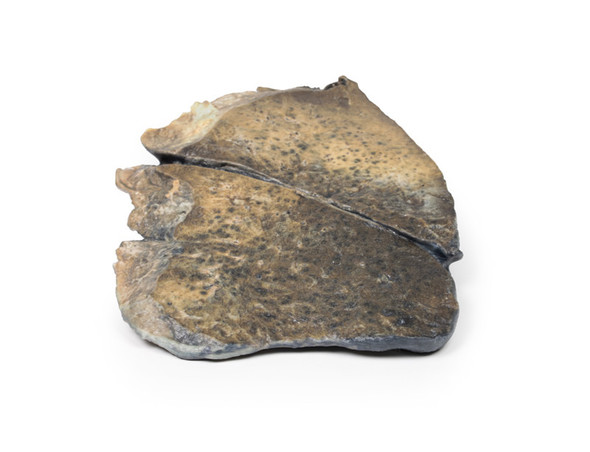Description
Clinical History
There is no clinical history for this specimen.
Pathology
The specimen is a parasagittal section of the right lung and the boundaries between the three lobes are visible. The entire upper and middle lobes are congested and hyperaemic* causing the darker appearance. There are smaller foci in the left lung.
Further Information
Lobar pneumonia is a form of pneumonia characterized by inflammatory exudate within the intra-alveolar space resulting in consolidation that affects a large and continuous area of the lobe of a lung. It is one of the two anatomic classifications of pneumonia (the other being bronchopneumonia). The affected lobe in this case shows classical red ‘hepatization’ or consolidation of the lung parenchyma, which is due to vascular congestion with extravasation of red cells into alveolar spaces, along with increased numbers of neutrophils and fibrin. The filling of the airspaces by the exudate leads to a gross appearance of solidification, or consolidation, of the alveolar parenchyma. This reddish appearance has been likened to that of cut surface of the liver, hence the term "hepatization". The most common organisms that cause lobar pneumonia are Streptococcus pneumoniae, also called pneumococcus, Haemophilus influenzae and Moraxella catarrhalis. Mycobacterium tuberculosis, the tubercle bacillus, may also cause lobar pneumonia if pulmonary tuberculosis is not treated promptly. Other organisms that lead to lobar pneumonia are Legionella pneumophila and Klebsiella pneumoniae. Like other types of pneumonia, lobar pneumonia can present as a community-acquired infection, in immune suppressed patients or as nosocomial infection. However, most causative organisms are of the community-acquired type. On a posteroanterior and lateral chest radiograph, an entire lobe will be radiopaque with no evidence of air within it, indicative of lobar pneumonia. *Hyperaemia = active engorgement of vascular beds with a normal or decreased outflow of blood.












